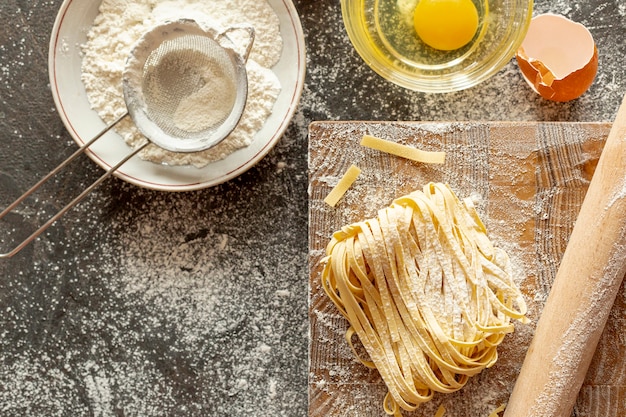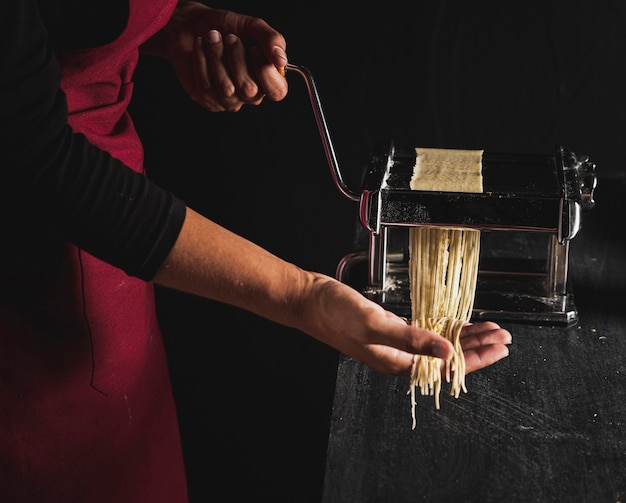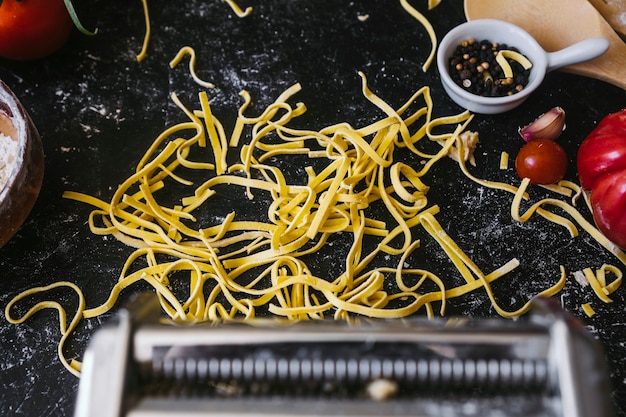(Part 1) Setting the Stage: The Boiling Water

Think of boiling water as the foundation of your spaghetti journey. It's not just about getting it hot, it's about creating the perfect environment for your pasta to cook evenly and absorb flavor.
1. The Importance of Plenty of Water: A Big Pot for Big Flavors
The first rule of spaghetti cooking is to use a large pot. Imagine trying to cook your pasta in a tiny saucepan – it's like trying to fit a giant family into a shoebox! The pasta needs space to move around, to cook evenly, and to release its starches, which will later create a lovely creamy sauce. Aim for at least 6 quarts of water for every pound of spaghetti. That's a generous amount, and it's worth it for the delicious results!
2. Salt: The Secret Weapon of Flavor
Now, let's talk about salt. I'm not talking about a pinch here, I'm talking about a generous amount! Salt brings out the natural flavors of the pasta, making it taste more vibrant and delicious. It also creates a flavorful base for your sauce. Think of it as seasoning your spaghetti before it even touches the sauce. A tip from my grandma: "Salt the water like you're seasoning a soup!"
3. Bringing the Water to a Rolling Boil: Let It Churn!
Once your pot is filled with water and generously seasoned, bring it to a roaring boil. You want to hear that water bubbling and churning – that's the sign it's ready for your pasta! The rapid boiling helps the pasta cook evenly and ensures that the starches release properly. Don't be afraid to let it bubble, let it sing!
(Part 2) Choosing Your Spaghetti: Types and Sizes

Now that your water is bubbling away, it's time to choose your weapon of choice – the spaghetti. But don't think it's just about grabbing the first box you see. There's a world of spaghetti options out there, each with its own unique character.
1. Spaghetti: The Classic Choice for a Reason
Spaghetti, the classic choice, is long, thin, and cylindrical. It's perfect for soaking up sauces and twirling around your fork. But even within the spaghetti world, there are different sizes. The most common size is No. 5, but you'll find other variations like No. 4 and No. 6. No. 4 is slightly thinner, while No. 6 is a bit thicker. The thickness affects the cooking time, so be sure to check the package.
2. spaghetti alla chitarra: A Flat Noodle with Character
Spaghetti alla chitarra is a flat, square-shaped spaghetti that's made by passing the dough through a special frame with thin wires, giving it a unique texture. The flat shape and rough surface create a different sensation in your mouth and help it hold on to the sauce. It's a great option for lighter sauces.
3. Spaghettini: Delicate and Delicious
Spaghettini is a thinner version of spaghetti, with a delicate texture and a more subtle flavor. It's perfect for delicate sauces and pairs beautifully with seafood.
4. Spaghetti Integrale: A Whole Wheat Delight
Spaghetti integrale is made with whole wheat flour, giving it a heartier texture and a slightly nutty flavor. It's a more nutritious option, and it also cooks up beautifully with a variety of sauces.
(Part 3) The Art of Adding the Spaghetti: Gentle and Gradual

Okay, your water is boiling, your spaghetti is chosen, now it's time to add the pasta to the pot. This may seem simple, but there's a right way and a wrong way to do it, and the difference will be noticeable on your plate.
1. Avoid Overcrowding the Pot: Give the Pasta Room to Breathe
Think of it as a party: you wouldn't invite everyone you know to a tiny apartment, would you? The same goes for your pasta. Adding too much spaghetti at once will cool down the water temperature, making it difficult for the pasta to cook evenly. Imagine trying to cook your spaghetti in a crowded pot – it's a recipe for disaster! Instead, add the spaghetti slowly, in batches, leaving plenty of space for the noodles to move freely and cook evenly.
2. The Gentle Stir: Prevent a Pasta Clump
Once your spaghetti is in the water, give it a gentle stir. This prevents the noodles from sticking together and ensures that they cook evenly. A gentle hand is key here. We're not trying to break the pasta, just helping it cook evenly and move freely.
(Part 4) The Cooking Time: The Real Trick
Now, the big question: how long do you cook the spaghetti? The answer isn't as simple as it seems. It depends on the brand, the type of pasta, and even the thickness of the noodles. But there are some general guidelines to follow.
1. The Package Is Your Guide: Trust the Instructions
Always, always, always check the package instructions! Every brand and type of spaghetti has a specific cooking time, so don't rely on guesswork. I learned this the hard way with a box of spaghettini that cooked for 7 minutes, not the 10 minutes I was used to with regular spaghetti. The package is your best friend, so trust it!
2. Al Dente: The Perfect Bite, Not Mushy or Hard
The goal is to cook the spaghetti al dente, which means "to the tooth" in Italian. al dente pasta is cooked through but still has a slight resistance when you bite into it. It's not mushy, but not hard either. Imagine a nice, firm bite, with a bit of bounce – that's al dente perfection.
3. The Pasta Test: Your Culinary Compass
To test if your spaghetti is al dente, remove a single noodle and bite into it. If it's cooked through but still has a slight bite, it's ready! If it's too hard, cook it for another minute or two. If it's too soft, it's overcooked, and you might need to start over (sorry!).
(Part 5) The Drain: The Final Step
Your spaghetti is al dente, you're ready to drain it. But be careful, there's a little trick here too, one that will transform your sauce and make it even more delicious.
1. Reserving the Pasta Water: A Secret Ingredient
Before you drain the spaghetti, use a ladle to scoop out a cup or two of the pasta water and set it aside. This is called "pasta water," and it's a secret weapon for making your sauce extra creamy and delicious. It's packed with starch, which helps the sauce cling to the noodles, creating a silky texture that coats every bite beautifully.
2. Don't Rinse: Preserve the Flavor and Texture
And here's a tip I learned the hard way: don't rinse the spaghetti after draining it! Rinsing washes away the starch, which is essential for making a creamy sauce. Let the pasta water do its magic!
(Part 6) Putting It All Together: The Sauce
You've got your perfectly cooked spaghetti, you've got your reserved pasta water, now it's time to add the sauce. But the magic doesn't stop here!
1. Adding the Pasta Water: Transforming Your Sauce
Add a little bit of pasta water to your sauce, just a tablespoon or two. It helps to emulsify the sauce, creating a silky texture that clings to the spaghetti beautifully. Think of it as a magical touch that elevates your sauce from ordinary to extraordinary.
2. Tossing the Pasta: A Symphony of Flavors
Once your sauce is ready, add the spaghetti to the pan and toss it gently to coat it evenly. Don't be afraid to toss it around, let the sauce embrace the spaghetti. This is where the symphony of flavors begins – the pasta, the sauce, the pasta water all coming together to create a truly delicious experience.
(Part 7) Serving It Up: The Final Touch
Your spaghetti is coated in a delicious sauce, it's time to serve it up! But before you dig in, let's add those final touches that elevate the dish to perfection.
1. A Garnish of Parmesan: A Classic Touch
If you're serving a traditional Italian sauce, a generous sprinkle of grated Parmesan cheese is a must. It adds a lovely salty flavor and richness to the dish, complementing the sauce beautifully.
2. A Touch of Fresh Herbs: A Burst of Flavor
A sprinkle of fresh herbs like basil, oregano, or parsley adds a burst of fresh flavor and aroma to your spaghetti. It's like a little burst of sunshine on your plate.
3. A Side of Bread: Soaking Up the Goodness
And finally, don't forget a side of crusty bread to soak up any leftover sauce. You don't want to waste even a drop of that deliciousness!
(Part 8) Beyond Spaghetti: Other Pasta Options
Now, you might be thinking, "Spaghetti is great, but what about other types of pasta?" The world of pasta is vast, offering a plethora of shapes, sizes, and textures, each one perfect for a different type of sauce and culinary experience.
1. The Versatility of Pasta: A World of Shapes and Flavors
Pasta is incredibly versatile and pairs well with a variety of sauces. Here are some other pasta options you can try:
- Penne: These penne are perfect for chunky sauces like Bolognese. Their unique shape allows for the sauce to nestle inside, creating a satisfying bite.
- Fusilli: These corkscrew-shaped pasta are ideal for creamy sauces. Their twists and turns provide a delightful surface area for the sauce to cling to.
- Linguine: These long, flat noodles are best with seafood sauces. The thin, flat shape helps to capture the delicate flavors of the seafood and create a graceful presentation.
- Rigatoni: These large, tube-shaped pasta are excellent for holding meat sauce. Their ridges provide a perfect surface for the sauce to cling to, creating a rich, flavorful bite.
(Part 9) The Spaghetti FAQs
Now let's address some of those questions you might have about cooking spaghetti:
1. What if I Overcook the Spaghetti?
If you overcook the spaghetti, it will be mushy. There's not much you can do to fix it, but don't throw it out! You can use it for other dishes like pasta salad or soup.
2. What if I Undercook the Spaghetti?
If you undercook the spaghetti, it will be hard. Don't worry, simply cook it for a few more minutes.
3. Can I Use Tap Water?
You can use tap water, but using filtered or bottled water is best. Tap water can sometimes have minerals that can affect the taste of the pasta.
4. Can I Cook the Spaghetti in the Microwave?
It's not recommended to cook spaghetti in the microwave. It doesn't cook evenly, and the results aren't very good.
5. Can I Use a pressure cooker to Cook Spaghetti?
Yes, you can cook spaghetti in a pressure cooker. Just follow the manufacturer's instructions. It takes less time to cook in a pressure cooker.
(Part 10) The Final Word: Your Spaghetti Journey Begins Here
And there you have it! Your comprehensive guide to cooking perfect spaghetti. Remember, it's all about practice and a bit of intuition. Don't be afraid to experiment with different types of spaghetti, sauces, and cooking methods.
So, go forth and conquer the world of spaghetti! Remember, every plate of perfectly cooked spaghetti is a victory for your culinary skills. Buon appetito!
(Part 11) The spaghetti recipe: A Simple Classic
Ready to get cooking? Here's a simple spaghetti recipe to get you started!
Spaghetti with Tomato Sauce
Ingredients:
- 1 pound spaghetti
- 1 (28-ounce) can crushed tomatoes
- 1 (15-ounce) can tomato sauce
- 1/2 cup chopped onion
- 2 cloves garlic, minced
- 1 teaspoon dried oregano
- 1/2 teaspoon salt
- 1/4 teaspoon black pepper
- 1/4 cup chopped fresh basil
- Grated Parmesan cheese, for serving
Instructions:
- Bring a large pot of salted water to a boil. Add the spaghetti and cook according to package directions, until al dente.
- While the spaghetti is cooking, heat a large skillet over medium heat. Add the olive oil, onion, and garlic. Cook until softened, about 5 minutes.
- Add the crushed tomatoes, tomato sauce, oregano, salt, and pepper. Bring to a simmer and cook for 15-20 minutes, stirring occasionally.
- Add the cooked spaghetti to the sauce and toss to coat.
- Serve with a sprinkle of fresh basil and grated Parmesan cheese.
Enjoy!
(Part 12) The Spaghetti Experience: A Personal Reflection
Remember that first spaghetti attempt, the one with the mushy pasta and the watery sauce? I felt like a culinary disaster, but I learned from that experience. Spaghetti has become a dish that represents my journey in the kitchen, a dish that I now approach with confidence and a touch of pride.
Spaghetti has a way of bringing people together. It's a dish that can be dressed up or down, a dish that evokes memories of family gatherings, cozy evenings, and shared laughter. Whether I'm whipping up a simple weeknight meal or crafting a special occasion feast, spaghetti always feels like a comforting hug. It's a dish that's easy to cook, but it's also a dish that can be made with love and passion.
I hope this guide has inspired you to try your hand at cooking perfect spaghetti. You'll find it's not as complicated as you might think. So go on, give it a try! You might just surprise yourself. And who knows, maybe you'll even find your own spaghetti story.
(Part 13) A Table of pasta shapes and Their Best Sauce Matches
To help you explore the world of pasta, here's a table that pairs different pasta shapes with their best sauce matches:
| Pasta Shape | Best Sauce Match |
|---|---|
| Spaghetti | Tomato-based sauces, creamy sauces, pesto |
| Penne | Chunky sauces like Bolognese, pesto, creamy sauces |
| Fusilli | Creamy sauces, pesto, tomato-based sauces |
| Linguine | Seafood sauces, pesto, light tomato sauces |
| Rigatoni | Meat sauce, chunky vegetable sauces, creamy sauces |
| Farfalle (Bow Tie) | Creamy sauces, pesto, light tomato sauces |
| Tortellini | Broth-based soups, creamy sauces |
| Lasagna Sheets | Meat sauce, béchamel sauce, ricotta cheese |
Remember, these are just suggestions. Don't be afraid to experiment and find your own favorite combinations!
Everyone is watching

How to Cook Frozen Lobster Tails Perfectly: A Step-by-Step Guide
RecipesLobster. Just the word conjures up images of lavish meals, special occasions, and a taste of luxury. But let's...

Pork Fillet Cooking Time: How Long to Cook It Perfectly
RecipesPork fillet, or tenderloin as it's sometimes called, is a real favourite in our house. It's so versatile, and...

Pigs in a Blanket Cooking Time: How Long to Bake for Perfect Results
RecipesAh, pigs in a blanket. Just the name conjures up images of those delightful little parcels of crispy pastry en...

The Ultimate Guide to Cooking Delicious Frankfurters
RecipesLet's face it, we all love a good frankfurter. It's a classic, simple, and always satisfying. But let's be rea...

Wolf Meat Recipes: A Guide to Cooking Wild Game
RecipesLet's be honest, you don't see wolf meat at your local butcher shop every day. It's a bit of a wild card, but ...
